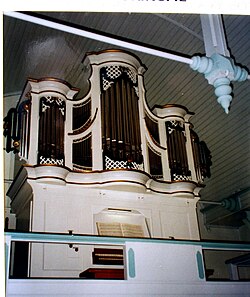Organ of the Christ Church (north)
| Organ of the Christ Church (north) | |
|---|---|

|
|
| General | |
| alternative name | Organ of the Christ Church |
| place | Christ Church (north) |
| Organ builder | Johann Gottfried Rohlfs |
| Construction year | 1796-1799 |
| Last renovation / restoration | 1998 |
| epoch | classicism |
| Organ landscape | Ostfriesland |
| Technical specifications | |
| Number of registers | 11 |
| Number of rows of pipes | 14th |
| Number of manuals | 2 |
| Tone tract | Mechanically |
| Register action | Mechanically |
| Number of 32 'registers | - |
| Number of 64 'registers | - |
The organ of the Christ Church (north) of the Esenser organ builder Johann Gottfried Rohlfs in the Evangelical Free Church Christ Church ( Baptist community ) on Osterstrasse is the second oldest organ in the north (East Friesland) . The organ was built in the Baroque tradition in 1796–1799 and initially installed in the Mennonite Church in the north . Today it has eleven registers , two manuals and a pedal .
Building history
At the end of the 18th century, Heere Dirks Stroman, site manager of the North Mennonite community , commissioned Rohlfs to design and then build an organ for the church hall of the long-established free church . The agreed price of 400 Reichsthalers was pooled in the years 1796–1797 by 87 “young men and virgins” of the Mennonite community and given to the community. The organ made by Rohlfs initially only had a keyboard with probably seven registers and an attached pedal.
The Rohlfs organ was expanded for the first time in 1890. The organ builder Johann Diepenbrock from northern Germany added a Principal 8 ′. The acceptance took place on November 6, 1890.
Around 1900 the organ builder Wilhelm Bruns prepared a new report in which, among other things, some registers were in need of renovation. The lack of the attached pedal and the lack of a second manual were also criticized. The Northern Mennonites decided on a new organ on the basis of this report. The Rohlfsorgel was sold for 450 gold marks to the Northern Baptist congregation , which had it built into their new church on Osterstrasse (today: Christ Church).
In the war years 1914–1918, most of the tin pipes had to be delivered for armament purposes. The Baptist congregation received 571.12 RM for this . After the war, the Praestant 4 ′ prospect pipes were replaced by inferior sheet zinc pipes .
The Rohlfs organ underwent another change in the post-war years 1948–1949. The organ builder Puchar converted the previously attached pedal into an independent one. Between 1958 and 1959 the organ was further expanded. The Alfred Führer company ( Wilhelmshaven ) overhauled the organ and added a second manual and a pedal bass. The organ case with the console in the front center remained essentially unchanged. The lower manual covered with bones was also preserved. The wind chest (slider chest) also went back to the first builder. During the conversion, it was only divided and received a second valve box at the front for the upper manual. The range is still C – d 3 .
Disposition 1959:
|
|
|
||||||||||||||||||||||||||
- Coupling : I / II, I / P.
- Notes I.
During these renovations, modern (plastic) components were sometimes used for the time, which led to the fact that the action mechanism became stiff over time and the sound lost power and shine due to the loss of wind in the feeds.
Organ builder Bartelt Immer from Norden carried out a general overhaul of the technical system of the organ in the workshop in 1994. Here the wind chest was completely dismantled and repaired. The case parts were stripped off and were given the original white color, which can also be seen on the Veenhusener Rohlfs organ from 1801. The Rohlfs registers, which were previously distributed across both plants, were combined in the Oberwerk; Bell 1 ′ became Quint 1 1 ⁄ 3 ′. The exchange of the Praestant register (zinc pipes) for Principal 4 ′ (corresponding to the version known from Rohlfs) was postponed to 1998 for financial reasons.
In 1998 the missing Rohlfs registers were reconstructed:
- Principal 4 ′ (made of lead pipes with 28% tin content with round labia; in the brochure these pipes are covered with tin foil)
- Nasat 3 ′ (tapering conically towards the mouth)
- Mixture III
Since Rohlfs always used the same scale lengths on 4 'organs, the registers could easily be copied from his organ in Veenhusen. The organ in its current state offers a self-contained sound character that corresponds to Rohlfs' intention.
On May 9th, 1998 the 200th birthday of the organ was celebrated. Cantor Reinhard Ruge, organist at the Arp Schnitger organ in the Norder Ludgeri Church, played the instrument at this celebration . With his expert opinion and the supervision of the renovation work, Ruge made a significant contribution to the preservation of this second oldest organ in the north.
Disposition since 1998
|
|
|
|||||||||||||||||||||||||||
- Coupling : I / II, I / P.
- Notes II
Technical specifications
- Eleven registers
-
Action :
- Tone action: mechanical
- Stop action: mechanical
-
Mood :
- Height a 1 = 440 Hz
- Well-tempered mood
literature
- Enno Popkes : Old and new organs - old and young master organ builders . In: Our East Frisia . No. 24 , 1954.
- Mennonite community to the north (Ed.): 450 years of Mennonites in the north . Mahler, Ellerbek 2006.
- Walter Kaufmann : The organs of East Frisia . East Frisian Landscape, Aurich 1968.
Web links
Coordinates: 53 ° 35 ′ 48 " N , 7 ° 12 ′ 35.8" E